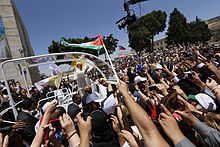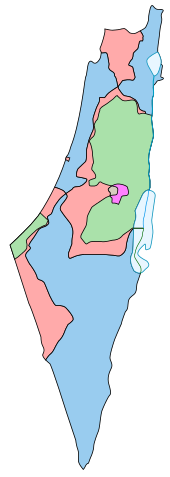Palestinian Declaration of Independence
| Palestinian Declaration of Independence | |
|---|---|
| Date effective | 15 November 1988 |
| Author(s) | Mahmoud Darwish |
| Full text | |
The Palestinian Declaration of Independence formally established the State of Palestine, and was written by Palestinian poet Mahmoud Darwish and proclaimed by Yasser Arafat on 15 November 1988 (5 Rabiʽ al-Thani 1409) in Algiers, Algeria. It had previously[1] been adopted by the Palestinian National Council (PNC), the legislative body of the Palestine Liberation Organization (PLO), by a vote of 253 in favour, 46 against, and 10 abstaining. It was read at the closing session of the 19th PNC to a standing ovation.[2] Upon completing the reading of the declaration, Arafat, as Chairman of the PLO, assumed the title of President of Palestine.[3] In April 1989, the PLO Central Council elected Arafat as the first President of the State of Palestine.[4]

Background
On 28 October 1974, the
Legal justification for the declaration was based on
Despite the 1988 proclamation of the
The PLO began to exercise a limited rule in the
Significance

Boundaries defined in the 1947 UN Partition Plan for Palestine:
Armistice Demarcation Lines of 1949 (Green Line):
The declaration concerned the
The Partition Plan served as the basis for
The declaration's reference to Palestine being the "land of the three monotheistic faiths" has been held as recognising the Jewish historical connection to the land. Referring to "the historical injustice inflicted on the Palestinian Arab people resulting in their dispersion and depriving them of their
Consequences
The declaration was accompanied by a PNC call for multilateral negotiations on the basis of
As a result of the declaration, the United Nations General Assembly (UNGA) convened, inviting Yasser Arafat, Chairman of the PLO to give an address. United Nations General Assembly Resolution 43/177 was adopted "acknowledging the proclamation of the State of Palestine by the Palestine National Council on 15 November 1988," and it was further decided that "the designation 'Palestine' should be used in place of the designation 'Palestine Liberation Organization' in the United Nations system." One hundred and four states voted for this resolution, forty-four abstained, and two – the United States and Israel – voted against.[17] By mid-December, 75 states had recognised Palestine, rising to 93 states by February 1989.[18]
On 29 November 2012, the
On 31 December 2014, the United Nations Security Council voted down a resolution demanding the end of Israeli occupation and Palestinian statehood by 2017. Eight members voted for the Resolution (Russia, China, France, Argentina, Chad, Chile, Jordan, Luxembourg). However the resolution did not get the minimum of nine votes needed to pass the resolution. Australia and the United States voted against the resolution, with the United Kingdom, Lithuania, Nigeria, South Korea and Rwanda abstaining.[21][22][23]
See also
- All-Palestine Government
- Palestinian state
- Jordanian annexation of the West Bank
- Occupation of the Gaza Strip by the United Arab Republic
- International recognition of the State of Palestine
- State of Palestine
- Palestinian nationalism
- Israeli Declaration of Independence
Footnotes
| i. | ^ The Palestine Basic Law, approved by the PLC in May 2002, states unambiguously "Jerusalem is the Capital of Palestine" (source: [1]). Ramallah is the administrative capital where government institutions and foreign representative offices of Australia, Brazil, Canada Colombia, Czech Republic, Denmark, Finland, Germany, Malta, the Netherlands, South Africa, and Switzerland are located. Jerusalem's final status awaits future negotiations between Israel and the Palestinian Authority (see "Negotiating Jerusalem", University of Maryland). The United Nations and most countries do not accept Israel's claim over the whole of Jerusalem (see Kellerman 1993, p. 140) and maintain their embassies to Israel in other cities (see the CIA Factbook). |
References
- ^ Dan Cohn-Sherbok,The Palestinian State: A Jewish Justification, Impress Books, 2012 p.105.
- ^ Sayigh, 1999, p. 624.
- ^ Silverburg, 2002, p. 198.
- ^ Tom Lansford, Political Handbook of the World 2014, p. 1628. CQ Press, March 2014.
"On April 2, 1989, the PLO's Central Council unanimously elected Arafat president of the self-proclaimed Palestinian state and designated Faruk Qaddumi as foreign minister ..." - ISBN 0-521-41523-3. p 21.
- ^ Berchovitch and Zartman, 2008, p. 43.
- ^ Baroud in Page, 2004, p. 161.
- ^ "Political Statement accompanying the Palestinian Declaration of Independence". Archived from the original on April 20, 2001.
- ^ a b "Le Monde diplomatique - Mensuel critique d'informations et d'analyses". www.monde-diplomatique.fr.
- ^ Silverburg, 2002, p. 42.
- ^ a b Quigley, 2005, p. 212.
- ^ PLO Negotiations Affairs Department (13 November 2008). "The Historic Compromise: The Palestinian Declaration of Independence and the Twenty-Year Struggle for a Two-State Solution" (PDF). Archived from the original (PDF) on 26 April 2012. Retrieved 6 February 2010.
- ^ Political communique Archived 2001-04-20 at the Wayback Machine Palestine National Council. Algiers, November 15, 1988. Official translation.
- ^ Arafat Clarifies Statement to Satisfy U.S. Conditions for Dialogue, 14 December 1988 – Jewish Virtual Library
- JSTOR 2537663.
- ISBN 0-520-08390-3.
- ^ "THE PALESTINE DECLARATION TO THE INTERNATIONAL CRIMINAL COURT: THE STATEHOOD ISSUE" (PDF). Rutgers Law Record. May 6, 2009. Archived from the original (PDF) on July 16, 2011. Retrieved 2009-07-19.
- ^ The Palestine Yearbook of International Law; Kassim, 1997, p. 49.
- ^ UNGA, 29 November 2012; Resolution 67/19. Status of Palestine in the United Nations (doc.nr. A/RES/67/19); Draft-resolution: A/67/L.28 Archived 2012-12-05 at the Wayback Machine d.d. 26 November 2012
- ^ "Palestine poised for symbolic but historic victory at UN". Zee News. 29 November 2012. Retrieved 29 November 2012.
- ^ "UNSC rejects resolution on Palestinian state". Al Jazeera. 31 December 2014. Retrieved 31 December 2014.
- ^ "UN Security Council rejects Palestinian resolution". BBC News. British Broadcasting Corporation. 31 December 2014. Retrieved 31 December 2014.
- ^ "UN security council rejects Palestinian statehood bid". The Guardian. Associated Press. 31 December 2014. Retrieved 31 December 2014.
External links
![]() The full text of the Palestinian Declaration of Independence at Wikisource translated by Edward Said
The full text of the Palestinian Declaration of Independence at Wikisource translated by Edward Said
- Original text in Arabic (with a readable option of translation by Google)
- Translation at UN website (errata)
- Palestinian Statehood: Trapped between Rhetoric and Realpolitik, Paul Eden, in The International and Comparative Law Quarterly, Vol. 62, No. 1 (JANUARY 2013), pp. 225–239]. (JSTOR)
Bibliography
- Kellerman, Aharon (1993). Society and Settlement: Jewish Land of Israel in the Twentieth Century. State University of New York Press. ISBN 0-7914-1295-4.
